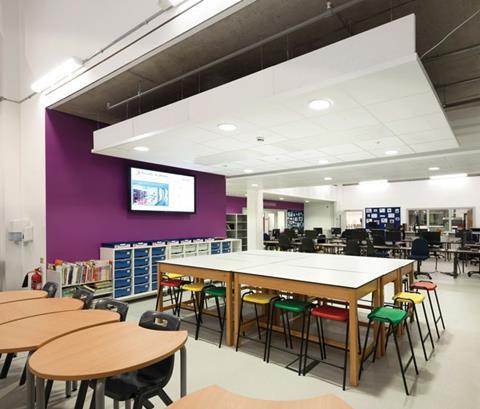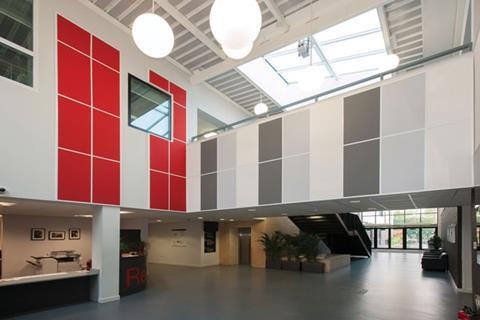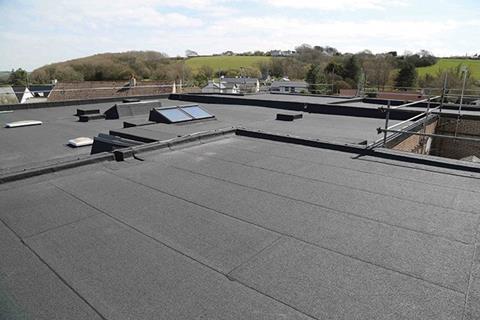Poor acoustics can have a damaging effect on teaching and learning. This module outlines the key contributary factors and some of the most effective solutions. It is sponsored by ROCKWOOL

How to take this module
UBM’s CPD distance-learning programme is open to anyone seeking to develop their knowledge and skills. Each module also offers members of professional institutions an opportunity to earn between 30 and 90 minutes of credits towards their annual CPD requirement.
This article is accredited by the CPD Certification Service. To earn CPD credits, read the article and then click the link below to complete your details and answer the questions. You will receive your results instantly, and if all the questions are correctly answered, you will be able to download your CPD certificate straight away.
CPD CREDITS: 60 MINUTES
DEADLINE: 6 NOVEMBER 2015


INTRODUCTION
Noise and poor acoustics are increasingly important issues in schools. This is partly a result of design and educational trends: the use of hard materials, such as glass, metal and plaster, results in surfaces that reflect sound, creating very noisy rooms. Likewise, the move towards flexible open-plan learning spaces, while accommodating a variety of teaching methods, also contributes to louder environments.
At the same time, a large body of recent research has shown that classrooms that are either too reverberant or simply too noisy can have a detrimental effect on educational outcomes. Background noise from services, activities in adjacent rooms or foot traffic can make it difficult for teachers to be heard and understood and for students to concentrate. For example, a 2002 study by B Shield and J Dockrell published in the Proceedings of the Institute of Acoustics compared external noise levels at over 50 London schools with the schools’ scores in standardised assessment tests (SATs) of children aged 7 and 11. It found that there is a significant relationship between increased external noise levels and lower SAT scores.
This CPD will examine the factors that contribute to poor acoustics in schools and set out some of the key performance standards, as well as outlining the main solutions for reducing unwanted noise.
KEY ACOUSTIC FACTORS
Reverberation
Reverberation (the amount of echo in a room) affects how well speech is understood. The main factors affecting reverberation are the geometry of the room and the amount and distribution of absorbent materials. Long reverberation times typically occur in rooms with hard reflective surfaces, giving rise to a “live” acoustic environment. Rooms with soft absorptive surfaces have short reverberation times and are described acoustically as being “dry” or “dead”. When classrooms have longer reverberation times, this can be frustrating and stressful, as the teacher must speak more loudly and with reduced intelligibility. Young children particularly experience huge difficulties in understanding speech in highly reverberant rooms.
For these reasons, one of the key parameters when measuring the acoustic performance of any space is reverberation time, or RT. This is defined as the time taken for a sound to decay by 60dB from its initial level. The lower the reverberation time, the less “echoey” the room. RT is traditionally measured using an impulsive source such as a gunshot or balloon burst, although it is now common to use a loudspeaker source emitting interrupted broadband noise or swept sine waves.
RTs vary depending on frequency, and in most rooms the RT at low frequencies is longer than at mid and high frequencies. This is because most commonly encountered materials such as carpets and curtains are least acoustically absorptive at low frequencies.
Building Bulletin 93: The Acoustic Design of Schools (BB93), which sets out the mandatory acoustic requirements for schools (see “Legislation and Guidance” below), defines acceptable RTs in terms of the mid-frequency reverberation time “Tmf”. This is the average of the values at 500, 1,000 and 2,000Hz for unoccupied and unfurnished rooms. The criteria for classrooms are set out in table 1 (overleaf).
Table 1: Acceptable reverberation times for classrooms
| Room / area type | Tmf |
|---|---|
| Primary school classrooms | 0.6 seconds or lower |
| Secondary school classrooms | 0.8 seconds or lower |
| Classrooms designed specifically for use by hearing-impaired students | 0.4 seconds or lower |
Table 2: Upper limits for IANL during normal teaching hours
| Type of room | Upper limit for IANL (dB) | Room classification for the purpose of airborne sound insulation (see table 3) | |
|---|---|---|---|
| Activity noise (source room) | Noise tolerance (receiving room) | ||
| Nursery school rooms, primary classrooms, secondary classrooms | 35 | Average | Medium |
| Open-plan teaching areas | 40 | Average | Medium |
| Primary music classroom | 35 | High | Medium |
| Secondary music classroom | 35 | Very high | Low |
| Lecture room | 35 | Average | Medium |
| Classrooms designed specifically for use by hearing-impaired students | 30 | Average | Low |
Table 3: Minimum standards for airborne sound insulation between new-build room
| Minimum DnT,w (dB) | Activity noise in source room | ||||
|---|---|---|---|---|---|
| Low | Average | High | Very high | ||
| Noise tolerance in receiving room | High | n/a | 35 | 45 | 50 |
| Medium | 40 | 45 | 50 | 55 | |
| Low | 45 | 50 | 55 | 55 |

Background noise
A teacher’s ability to be heard and understood, and a student’s ability to concentrate and think, are also negatively affected by background noise in classrooms. This may be from a number of sources, including heating, ventilation and air conditioning (HVAC) installations, foot and street traffic, adjacent rooms and corridors, shuffling of chairs or student noise. Moreover, high RTs can contribute to background noise through the “Lombard effect”, which describes how people tend to speak more loudly to overcome reverberant noise.
This area is gaining in importance as more group tasks are performed in today’s schools: background noise can lead to miscommunication, frustration and stress.
A key measure for gauging the effect of background noise is the signal-to-noise ratio. “Signal” stands for the speech level of the speaker; “noise” stands for all background noise present in the room (expressed in dB). The higher the ratio, the less disturbing the background noise is. For optimal speech intelligibility, a signal-to-noise ratio of at least 15dB is recommended. For younger children or children with hearing impairments, a ratio of 20-25dB is advised.
BB93 addresses background noise in terms of the indoor ambient noise level (IANL). This includes noise from external sources such as road and rail traffic and industrial premises, building services, actuators and dampers. It excludes noise from equipment used within the space and noise from staff, students and equipment within the building or playground. This is because noise transmitted from adjacent spaces is addressed by separate requirements for airborne and impact sound insulation.
Table 2 (left) specifies upper limits for IANL during normal teaching hours for new-build classrooms. Table 3, meanwhile, shows the minimum standards for airborne sound insulation required between new-build rooms. These values are defined by the activity noise in the source room and the noise tolerance in the receiving room as given in table 2. For example, insulation between two secondary classrooms (which have average activity noise and medium noise tolerance) must reduce sound by 40dB. This is assessed as the standardised level difference (DnT) in accordance with BS EN ISO 16283-1, and the results are weighted and expressed as a single number (DnT,w) in accordance with BS EN ISO 717-1.
The maximum impact sound levels in new-build primary and secondary classrooms, as well as many other education spaces such as libraries, drama studios, ICT rooms and assembly halls, is 60dB. For teaching spaces intended specifically for students with special hearing or communication needs, it is 55dB.

Rain noise
The IANL in BB93 excludes noise contributions from rain. However, Building Regulation submissions should demonstrate that lightweight roofs and roof glazing have been designed to provide suitable control of reverberant rain noise. Levels during heavy rain should not be more than 25dB above the appropriate IANL given in table 2. Predictions for rain noise can be accurately made based on test data and formulas in BS EN ISO 140-18:2006.
The environmental rating system BREEAM for Schools also provides credits for roof designs that can demonstrate that the ambient sound pressure level will not exceed normal allowable ambient sound levels by more than 25dB in the event of heavy rain, in line with BB93.
REGULATIONS AND GUIDANCE
Acoustic conditions in schools are controlled by Part E of the Building Regulations, the criteria for which are set out in section one of BB93. This was updated in 2015.
However, there are other important regulations that school designers need to adhere to:
The School Premises RegulationsUnlike Part E of the Building Regulations, which applies only to learning and teaching spaces, the School Premises Regulations apply to all areas of schools, and also to nursery schools. School client bodies are responsible for ensuring compliance with the School Premises Regulations.
In addition to the design and construction standards covered by Part E, the School Premises Regulations cover the performance in use of schools, including speech intelligibility in classrooms. This means that operational noise levels (for example, of equipment) will need to be suitable for the activities taking place and open-plan teaching spaces will need to provide adequate speech intelligibility as measured by the speech transmission index (STI). This value describes how well speech is heard and understood on a scale from 0 (bad) to 1 (excellent). An STI of 0.6 or higher is required for open-plan teaching spaces. The STI should be calculated in accordance with BS EN 60268-16:2011.
Independent School Standards
These standards apply to the independent school estate and cover performance in use of spaces in the same way as the School Premises Regulations.
The Equality Act 2010The Equality Act places a duty on all schools and local authorities to prepare and implement accessibility strategies and plans for disabled pupils and staff. This could involve the provision of acoustic improvements, as pupils with special educational needs are generally even more sensitive to the acoustic environment than others. Pupils with hearing impairments, autism and other special needs are often very sensitive to specific types of noise, particularly those with strong tonal, impulsive or intermittent characteristics.
INTRODUCTION TO ACOUSTIC SOLUTIONS
Suspended ceilings, baffles and islands
A ceiling combining high sound absorption and high sound insulation, such as ROCKFON ceiling systems, will reduce the reverberant sound level in classrooms as well as insulating against intrusive noise from service installations in the ceiling void and from adjacent spaces. Solutions that provide good absorption of low-frequency sounds are particularly important for improving speech intelligibility. Products are available with frequency-dependent sound absorption coefficients greater than 0.90, which means that 90% of the incident sound energy at that frequency is absorbed or dissipated. Floating islands and baffles can be used in thermal mass constructions, and can achieve weighted sound absorption coefficients of 0.85.
Wall absorbers
For bigger rooms, such as activity rooms and large classrooms over 250m3, the use of wall absorbers is recommended to reduce excessive reverberation caused by effects such as standing waves and flutter echoes and ensure optimum sound absorption. Wall absorbers should be used on at least two adjacent walls in order to ensure uniform speech intelligibility around the room. A 40mm wall absorber can achieve a weighted sound absorption coefficient of 0.95.
Floor constructions
Acoustic insulation can be applied to existing timber floor build-ups to reduce both airborne and impact sound. Tests have shown that platform floors incorporating two layers of high-performance insulation – one between joists, the other creating a floating floor – can reduce airborne sound by up to 66dB and impact sound by 58dB. The total thickness of insulation would be between 130mm and 150mm. Heavyweight concrete floors require less insulation to provide high levels of acoustic protection.

Roof constructions
The acoustic solution here will be dependent on the specific roof construction and may be provided by a combination of insulation materials. High-performance fibrous insulation, such as ROCKWOOL HARDROCK, provides very effective sound absorption within lightweight metal roofs. It also provides high levels of acoustic damping, which reduces the resonance created by the impact of rain.
Eliminating flanking
Flanking sound is transmitted indirectly via paths such as external wall cavities, voids above partitions and internal corridors. If the wall/floor/partition has good sound-reducing capabilities, then the sound will be transmitted via the path of least resistance – if it can’t go through the wall, it will go up and over or around the side. It is imperative that flanking transmission is considered at the design stage and that the construction detailing specified will eliminate or at least minimise any downgrading of the acoustic performance. To assist the designer, good practice detailing at key junctions is provided throughout Approved Document E. Solutions are presented showing the essential gap filling, joint sealing, firestopping, cavity closing and continuity of insulation to prevent sound transmission through critical junctions.

How to take this module
UBM’s CPD distance-learning programme is open to anyone seeking to develop their knowledge and skills. Each module also offers members of professional institutions an opportunity to earn between 30 and 90 minutes of credits towards their annual CPD requirement.
This article is accredited by the CPD Certification Service. To earn CPD credits, read the article and then click the link below to complete your details and answer the questions. You will receive your results instantly, and if all the questions are correctly answered, you will be able to download your CPD certificate straight away.
CPD CREDITS: 60 MINUTES
DEADLINE: 6 NOVEMBER 2015
Privacy policy
Information you supply to UBM Information Ltd may be used for publication and also to provide you with information about our products or services in the form of direct marketing by email, telephone, fax or post. Information may also be made available to third parties. UBM Information Ltd may send updates about Building CPD and other relevant UBM products and services. By providing your email address you consent to being contacted by email by UBM Information Ltd or other third parties. If at any time you no longer wish to receive anything from UBM Information Ltd or to have your data made available to third parties, contact the Data Protection Coordinator, UBM Information Ltd, FREEPOST LON 15637, Tonbridge, TN9 1BR, Freephone 0800 279 0357 or email ubmidpa@ubm.com. View our full privacy policy at www.building.co.uk/cpd




























1 Readers' comment